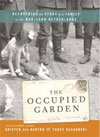Home > Books > The Occupied Garden
 |
| The Occupied Garden by Kristen den Hartog aTracy Kasaboski. |
The Occupied Garden :
Recovering the Story of a Family in the War-torn Netherlands
By Kristen den Hartog & Tracy Kasaboski
ISBN - 10:0771026226
ISBN - 13:9780771026225
Website: www.TheOccupiedGarden.com
Review by Rose Burke “The Occupied Garden” transported me to a past that is also part of my heritage - as my mother, a Dutch War Bride, also lived through the Second World War and the German occupation of the Nederlands. But one does not need Dutch heritage to be captivated by this book.
Written by their grand-daughters, “The Occupied Garden” tells the fascinating story of Gerrit and Cor den Hartog, whose wartime experiences led them to emigrate to Canada in 1951. Kristen den Hartog is an established author and her sister, Tracy Kasaboski, started writing stories in her childhood. Their efforts to document their grandparents’ lives during Holland’s occupation lead them to the neighbourhood of the Tedingerstraat (street) where they had lived in Leidschendam and to journals that provided poignant information of the daily struggles.
This important book strikes to the very core of the Dutch post-war psyche and one to which I can certainly relate, growing up not knowing so many things about my own mother and her Dutch family. Most Dutch people emotionally moved on after the war years, so I already knew the answer to the question posed by one of the their sources of information: “ ‘How is it that you do not know these things? – How is it you were not told?’” As den Hartog and Kasaboski explain, “Oma and Opa were not unique in their unwillingness to share their experience. It was typical of their culture and their generation, and a reaction to terrible times.”
Kasaboski and den Hartog have filled this gap through the recreation of their grandparents’ lives in their recently released book “The Occupied Garden.” By blending their careful research of events and motivations with intimate information gleaned from journals, they have created a personal and compelling account of the war years. We are introduced to Gerrit and Cor den Hartog before their marriage, and live with them through the German occupation. Gerrit’s life is defined by his market garden (tuin) and Cor’s by her unshakable devoutness. It is written as an observer who does not judge, but through Gerrit and Cor we experience the shattered innocence of a country that thought it could avoid war and see and feel how people cope with the unimaginable.
Gerrit den Hartog is a gardener, not a soldier, but like all able-bodied men he is called to active duty in the futile effort to repel the German invasion in May 1940. Gerrit, like many, are traumatized by the rapid and bitter defeat but the Dutch are a tough and stubborn people. Cor, unable to tolerate her fear for her husband, searches and finds him among the defeated soldiers. When lives return to a terrible new “normal”, each family must decide how to live with the occupiers, weighing resistance and aid to those in hiding against the safety of their children. Every edict from the Germans demands more and more from the Dutch people and requires harder decisions; every decision weighed against harsh penalties or the terrible work camps. The reader feels the emotions, the conflict and the pain of a people who quietly resist and provide aid to the neediest, the persecuted Jews.
Gerrit continues to grow his vegetables, but as more and more of the country’s resources are funnelled to the German war effort it is illegal to share them with his starving countrymen. However, he does share, and people continue to resist in spite of the price. The Liberation brings joy but the cost is high. It is not possible for the Allies to bomb the enemy without impact on the people and that last campaign brings the most desperate conditions of the hunger winter as everyone faces starvation and casualties are high.
Kristen den Hartog and Tracy Kasaboski are to be congratulated for capturing a time and a people, and for writing with an honesty and compassion that draws the reader so completely into Cor and Gerrit’s neighbourhood that one cannot help wondering what they would have done if faced with the same terrible wartime situation.
|




